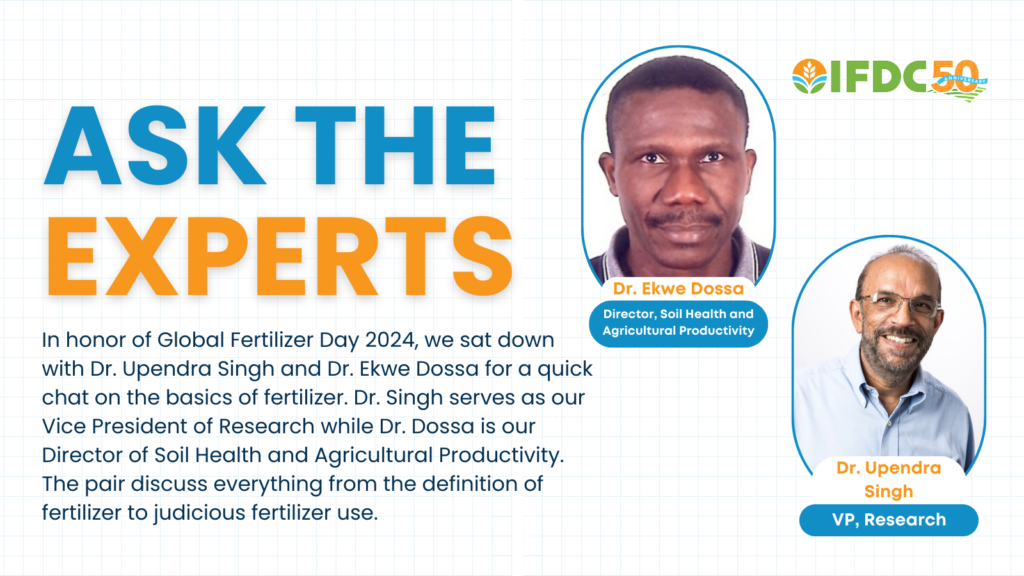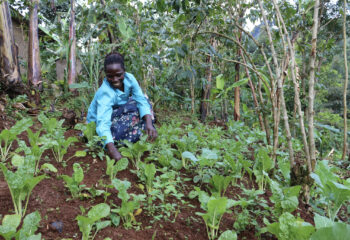
This Global Fertilizer Day, we sat down with Dr. Upendra Singh and Dr. Ekwe Dossa for a quick chat on the basics of fertilizer. Dr. Singh serves as our Vice President of Research while Dr. Dossa is our Director of Soil Health and Agricultural Productivity. The pair discuss everything from the definition of fertilizer to judicious fertilizer use.
What are fertilizers? How do types of fertilizer vary?
US: Fertilizers are basically any product or material that provides nutrients to the plant. Whether it comes in chemical or synthetic form, organic, manure, etc., all of these are fertilizer because they provide nutrients to the plant.
ED: A fertilizer is a concentration of nutrients available for the activity of the plant. It can be applied to the earth, added to irrigation water, or added to a foliar application to provide nutrients to the plant, thus supporting the development of the plant.
A chemical, or mineral, fertilizer is normally a fertilizer produced by artificial means, which is easily available, or accessible, to the plant. This fertilizer comes in the form of minerals. Once it is applied and water is available, plants can receive the nutrients.
Organic fertilizer is compost, animal byproducts, manure, and things like that. The nutrients are the same, but they are in organic forms. Organic fertilizer needs mineralization before being able to release the nutrients to the plants. That’s the difference. It is a slow-release fertilizer.
IFDC champions the innovative and environmentally conscious use of all types of fertilizer. PAGRIS, a recently concluded project, facilitated organo-mineral fertilizer production and context-specific fertilizer use in Burundi. SOILS-Space to Place is a project spanning much of sub-Saharan Africa, and it has been designed to make geospatial soil fertility information accessible to farmers to inform and offer recommendations for site-specific fertilizer application.
What misunderstandings about fertilizers would you like to address?
ED: A common view among economists is that the nutrients we get from organic fertilizers are different from those we get from mineral fertilizers. This is not true. They are the same.
The nitrogen in organic and mineral fertilizers is the same, and this is also true for the phosphate and potassium. There is no difference; they are just different forms of fertilizers.
Furthermore, fertilizers are not pesticides; they are necessary agricultural ingredients. Fertilizers provide plants with food that the soil lacks for optimal agricultural productivity. Pesticides protect the soil against insect invasions, diseases, and all the things that can damage plants and prevent them from developing optimally, stunting food production.
US: Plants are interested in getting their nutrients—like nitrogen, phosphorus, potash— whether it comes from a bag of fertilizer or from manure or compost that you apply.
The plant takes nutrients that come out of that fertilizer. When a plant takes nitrogen, which is needed for creating protein and so forth, it makes no difference whether that nitrogen is coming from a chemical fertilizer or from an organic product or from any other source. Nitrogen is nitrogen.
Fertilizers are often construed as a cause of environmental problems. When applied improperly, this can be true; fertilizers can lead to runoff or leaching and can disrupt ecosystem balances. However, fertilizers hold great power and potential as the solution to environmental problems. Dr. Rattan Lal, World Food Prize laureate and IFDC board member, has found that responsible fertilizer use can support the biological processes of soil that are otherwise disrupted by crop systems.
Tell us about fertilization and environmental pollution.
ED: While fertilization is a vital practice in agriculture, improper utilization can result in detrimental environmental consequences. There are three distinct categories of pollution in agriculture. The first is surface water contamination. The overapplication of fertilizer can be readily eliminated through judicious, responsible fertilization practices. The removal and subsequent refilling of water with fertilizer will inevitably result in its contamination, leading to its presence in surface waters, such as lakes. Ultimately, this will result in an increase in nutrients, and then, nutrient-rich water will support organic activities, including algae blooms, which reduce the oxygen available in the water. As the oxygen becomes depleted, aquatic life is threatened. This process is called eutrophication. In the end, water polluted with excess nutrients will no longer be capable of sustaining life, simply due to the lack of oxygen. This is my first point.
The second point to be considered is the pollution of groundwater. When fertilizer nutrients are broken down, some of them are easily mobilized, such as nitrate, which can easily move through the soil if it is not applied near the crust and plant. Afterward, it penetrates the soil, particularly in the rotation zones and subsequently discharges to the earth’s surface as groundwater. This is the water that we use for drinking and other purposes. When this water is high in elements like nitrate, it becomes unsuitable for consumption. A high nitrate content in the groundwater can cause “baby blue” syndrome, a condition that is very toxic to infants. It is therefore crucial to ensure the proper use of fertilizers to prevent the occurrence of adverse effects.
Another factor that merits consideration is air pollution. Certain fertilizers contain volatile nutrients, like nitrogen, which can undergo denitrification and be released into the atmosphere as nitroxide, a major issue for our ozone layer. The ozone layer is crucial, because it protects us against infrared radiation from the sun. By damaging the ozone layer, we damage human health.
IFDC is committed to conserving clean water for all, eliminating runoff and contamination, and mitigating greenhouse gas (GHG) emissions. Without sustainable agricultural practices, the amount of water available is vastly limited. The 4R Principles of Nutrient Stewardship are used to reduce nutrients runoff on the farm, preventing water pollution, air pollution, and GHG emissions.
Can fertilizers be overused? How do you use it effectively?
US: Yes, fertilizers can be overused, or misused, if we apply too much, because plants, like any living being, have their limits of how much they need.
If we overfeed the plant, it will take what it needs. The excess is left in the soil, and that is where the problem comes in. The excess nutrients are susceptible to losses, so when we have heavy rains, you can have leaching losses, runoff losses. There is also an opportunity for emissions or volatilization losses, where gases come out, so you can have ammonia in the air, you can have nitrous oxide, and all of those things have impacts on both the environment, in terms of the climate, and human health, from the ammonia.
As with anything that’s good, we can always abuse it and have negative impacts, and that’s why proper use is crucial. The right amount, the right time of application, the right method of application, and the right type of fertilizer are what we call the 4Rs of Nutrient Stewardship. If we follow these, we can largely eliminate many of the problems associated with the negative effects of overuse of fertilizer.
I think there’s a real need to look at making fertilizers much more climate-smart, much more resilient, so that it’s not a random thing, but the fertilizer is released when the plants need it, making life a lot easier for farmers. It will make it cleaner for the environment, because nutrients won’t be released when the plant doesn’t need them. I think that’s an area where we should be putting efforts in, in terms of looking at the next generation of fertilizers.
ED: Fertilizer is useful, but there is a deficit. This is a negative environmental impact. To minimize this deficit, you must use the fertilizer responsibly. There are four rules for using fertilizer in an ecological way:
The first is to use the right fertilizer. It’s necessary to use the fertilizer that the soil needs the most. That is the right fertilizer.
The second is to use the right rate of the right fertilizer. If you use too much fertilizer, the crust may be damaged. The right amount of fertilizer should not cause damage.
The third rule is to use the right fertilizer at the right time. Plants need nutrients to be applied at the right time. By applying fertilizer when plants need it most, we minimize any harmful impact.
The fourth rule is that fertilizer must be put in the right place, near the receiving area, so that the plants can use the fertilizer as much as possible and minimize damage. By placing the fertilizer where the plants can use it the most, we optimize the efficiency of nutrient use. We minimize nutrient damage and earn income from investments in the use of fertilizer in the soil.
Are fertilizers important to soil and human health?
US: Yes, fertilizers are important. If your soil is fertile and you grow on new land, your soil is providing all the nutrients. Basically, the soil has a high soil fertility. It provides all the nutrients and so there is really no need for an external application of fertilizer, whether it’s from any of the sources that I have mentioned. The problem comes when you continue to grow crops year after year, and the nutrients are not replenished.
The nutrients are being taken out of the soil—or mined from the soil—and then the plants are getting less of one nutrient or the other and that affects their performance. Just like if we don’t have enough zinc in our body, it causes stunted growth and so on. The same thing happens with plants. If we don’t apply fertilizers, if we don’t apply manures, they will not grow to their maximum potential, and so we will get a lower quantity as well as lower quality.
I think the quality side is very important for us because if we are eating food that does not have high nutrition, that also affects our own nutrition and health.
Fertilizer plays a role in achieving United Nations Sustainable Development Goal (SDG) 2: Zero Hunger. The goal’s targets include enhancing agricultural productivity for smallholder farmers and reducing malnutrition. Fertilizer contributes to both by replacing vital nutrients in the soil that support plant and human health.
Conversations around fertilizer are sometimes difficult, but they are crucial to improving public perceptions of it. Fertilizer’s utility for increasing yields and supporting soil health cannot be understated. We invite you to be part of the conversation! If you have any other burning questions about fertilizer, let us know on our social media so we can include them in future Q&As!




